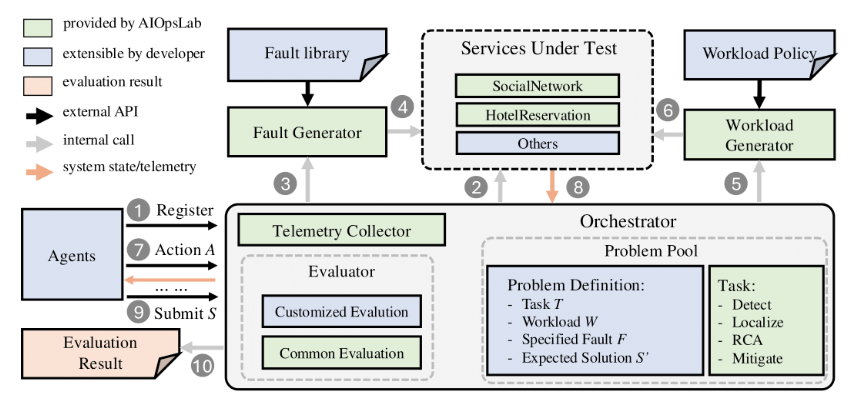Microsoft has joined hands with research institutions such as the University of California, Berkeley, and the University of Illinois to open the source of the cloud automation operation and maintenance intelligent agent system project called AIOpsLab. The project aims to realize automatic detection, location and resolution of failures by simulating a real cloud service environment, thereby significantly improving the observability and operation and maintenance efficiency of cloud services. AIOpsLab adopts a modular design, supports human-computer collaboration, and is highly scalable, making it easier for developers to deal with different workloads and failure scenarios. Its core functions include five key parts: coordinator, service, workload generator, fault generator and observability. Each part plays an important role in improving the efficiency of cloud service operation and maintenance.

The main function of AIOpsLab is to support the collaboration between humans and digital agents through modular design, which facilitates developers to expand applications and handle different workloads and failure scenarios. Its architecture consists of five key components: coordinator, service, workload generator, failure generator, and observability.
The coordinator is responsible for establishing a session with the agent and sharing information about benchmarking issues. It helps the agent to effectively solve tasks by calling a series of documented APIs (such as getting logs, metrics, etc.). The coordinator can also operate on behalf of the agent, such as extending or redeploying services, ensuring that the agent can operate smoothly in the actual environment.
The service module can adapt to a variety of real cloud service environments, such as microservices, serverless and single-services. AIOpsLab also leverages the open source application suite DeathStarBench, providing researchers with a tool to reproduce and study production events in a controlled environment. In addition, through the integration of tools such as Blueprint, AIOpsLab can also be extended to other academic and production services, allowing for rapid deployment of new variants.
Workload generators play an important role in AIOpsLab, and are responsible for creating simulations of normal and failure scenarios to test the performance of agents under different conditions. It generates corresponding workloads according to the specifications of the coordinator, helping users to test in a variety of situations.
The fault generator is an innovative feature of AIOpsLab that enables fine-grained fault injection in a variety of cloud scenarios. This function can simulate the entire process of complex failures and consider the interdependence between microservices, providing users with comprehensive testing and evaluation capabilities.
Finally, the observability function integrates multiple monitoring tools to improve the comprehensive monitoring capabilities of AIOpsLab, ensuring that users can obtain customized system information for effective management in the event of possible data overload.
Open source address: https://github.com/microsoft/AIOpsLab/?tab=readme-ov-file
Points:
Microsoft and universities jointly open source AIOpsLab, aiming to improve the automation operation and maintenance capabilities of cloud services.
AIOpsLab supports multiple cloud service environments through five major components: coordinator, service, workload generator, fault generator and observability.
Observability functions integrate multiple monitoring tools to ensure that users obtain effective system information and monitoring capabilities.
The open source of AIOpsLab provides new possibilities for improving operation and maintenance efficiency in the cloud-native field. Its modular design and powerful functions make it have a wide range of application prospects. We look forward to more developers participating in it and jointly improving and developing this project.